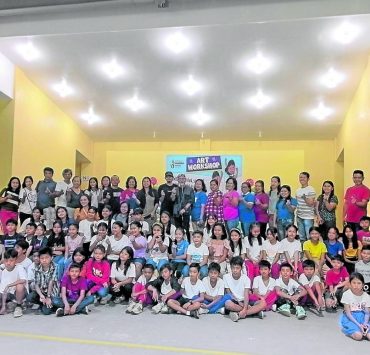How she turned her art into Manila’s playground
During the pandemic, oil painter Aina Zulueta Valencia experimented with acrylic ink and watercolor on paper depicting abstract images of flowers and landscapes. These paintings echoed the sentiments of most people quarantined in the city. They longed for open spaces and be soothed by the regenerative power of nature. It dawned on her that she wanted to transpose her art from a two-dimensional surface into a public area that would address a need in society.
In 2021, Valencia embarked on pursing a postgraduate degree in fine arts at the Lesley School of Art and Design in Massachusetts. The program allowed her to shuttle between the United States and the Philippines. During a workshop, conducted by painter Alex Jackson, he asked what kind of art would they want to be remembered by. Valencia’s impulse was to draw a playground with a garden without having any knowledge about plants and landscaping. She envisioned that she would merge art as an expression and as a social practice.
Her thesis became The Children’s Play Garden, which fills in the void of green, interactive spaces in the Manila. Green spaces comprise a meager .03 percent in the overbuilt Metro Manila. Most of them are golf courses, cemeteries and some residential gardens.
Loss of natural spaces
“Art can be about painting, sculpture, or it can be performative. It can also encompass community-based activities, and in my case, building a play garden of native Philippine trees,” says Valencia. “While painting about landscapes and gardens during the pandemic, I began to reflect a lot on the extreme loss of natural spaces in Metro Manila. I decided to move outside the studio to actualize a real space,” she says.
The National Parks Development Committee welcomed the idea of a play garden, a living classroom for endemic trees and an activity area because it would fill the void of children’s playgrounds in the city.
“The site is an artistic gesture and a practical response to issues of play and green space equity. It aims to humanize the urban living experience. Many children play on city streets or if they can afford it, go to the malls for the indoor playgrounds,” says Valencia.
The mini arboretum is part of the urban greening campaign for spaces where people can learn about native trees and the importance of cultivating them. Trees in a playground will make young people more aware of protecting our natural heritage.
Located in the western side of Rizal Park, near Burnham Green (across Quirino Grandstand), the 800-square meter The Children’s Play Garden is clustered with the Rice Garden and Urban Farm, the educational portion of Rizal Park.
Collaborative effort
Valencia acknowledges that the undertaking was a collaborative effort. The project was privately funded by her family’s business, Piandre Salon. She worked with architect Andrew Tan in designing the pods and the play space. The landscape design and choice of plants were executed by landscape architect Tovie del Rosario, plant expert Lydia Robledo and Rose Policarpio of the maintenance. They selected 33 native trees, small to medium trees, many of which were flowering.
Three cylindrical pods, made of slid metal frame and recycled plastic lumber comprise the focal point. Long lasting and waterproof, the recycled lumber was made from a ton of plastic bottle cops. The slides, seesaws, rope pyramid and swings were sourced from a playground manufacturer.
As a living classroom, the play garden not only educates children about the native trees. Valencia says cultivating native trees exclusively compensates for the common practice of planting nonnative tries in our parks, urban developments and forests which can be damaging to the land. These can also endanger biodiversity.
“Native trees are adapted to the climate and soil of the country and are more resistant to our extreme weather. Native trees attract native wildlife and are an amazing resource for traditional medicine and food. Non-native trees such as mahogany are invasive. They alter the soil around them, not allowing other native plants and species to grow,” she says.
The Children’s Play Garden is envisioned as a living art form. As a product of an 18-month team work, it evolved into a space that nurtures the spirit of the children who come to play, the caretakers and gardeners and the wildlife that will be attracted to the trees.
“All contribute to a long-term living installation,” says Valencia. —CONTRIBUTED INQ
















